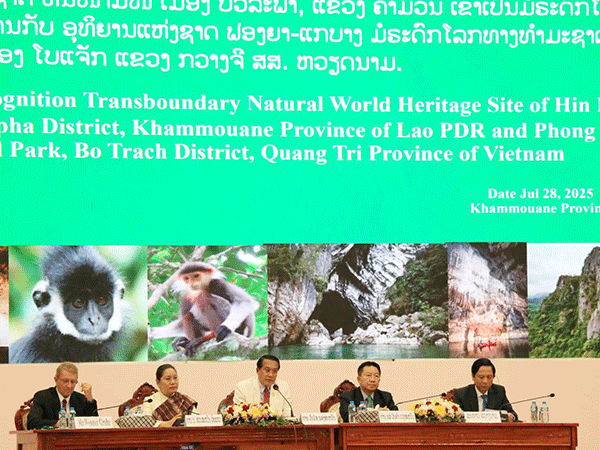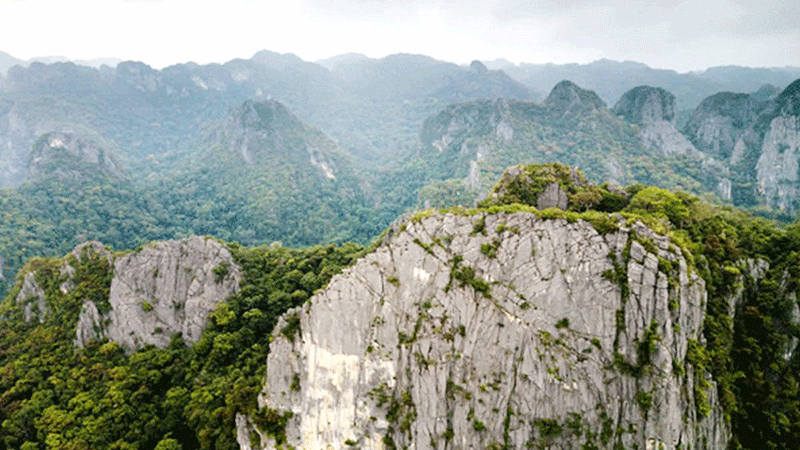 |
Minister of Culture and Tourism Mrs Suanesavanh Vignaket (second left), who is Chair of the National Heritage Management Committee. |
Khammuan to mark S.E. Asia’s first transboundary World Heritage Site with year-end celebration
Khammuan province: Khammuan authorities plan to hold a grand ceremony at the end of this year to celebrate the inscription of Hin Nam No National Park as a UNESCO World Heritage Site, making it the fourth World Heritage inscription in Laos.
The UNESCO World Heritage Committee approved the inclusion of Hin Nam No National Park alongside Vietnam’s Phong Nha-Ke Bang National Park at its 47th Session held in Paris, France, on July 13, creating the first transboundary World Heritage Site in Southeast Asia.
The park in Vietnam was recognised by UNESCO as a World Natural Heritage Site in 2003.
 |
The dramatic landscape of Hin Nam No National Park. |
Covering 94,121 hectares, Hin Nam No National Park features spectacular caves such as Xebangfay and provides a vital refuge for rare species like the Great Hornbill, Lao Rock Rat, and Southern White-cheeked Gibbon.
The planned celebration of Hin Nam No’s inscription by UNESCO was announced at a press conference held in Thakhaek district on Monday.
The press conference was given by Minister of Culture and Tourism Mrs Suanesavanh Vignaket, Minister of Agriculture and Environment Prof. Dr Linkham Douangsavanh, and the Governor of Khammuan province Mr Vanxay Fongsavanh, with numerous representatives from Laos, Vietnam, and international organisations in attendance.
The process to nominate Hin Nam No National Park as a World Heritage Site took more than 20 years, beginning in 1999.
However, due to limited facilities, there were difficulties around collecting the necessary geographical and biodiversity data.
Mr Vanxay noted that Hin Nam No National Park is rich in wildlife and biodiversity of a kind found nowhere else in the world. This, he said, is evidence that Khammuan province possesses natural and environmental features of global significance.
“The recognition of Hin Nam No National Park as a World Heritage Site was not easily achieved. Managing, protecting, and developing the park in an environmentally friendly and sustainable way, ensuring it becomes a truly valuable natural World Heritage Site, is a major challenge for us,” he said.
Khammuan authorities will step up efforts to raise public awareness about the importance, benefits, and values of natural World Heritage Sites, encouraging local communities to participate in their management and protection.
Authorities will also work with ministries and international experts to develop sustainable plans for managing, conserving, and developing these areas, while enhancing the livelihoods of local people.
In addition, Khammuan will collaborate with Quang Tri province in Vietnam to establish a joint transboundary World Heritage Site management system, improve eco-friendly infrastructure, and transform the area into a biodiversity learning centre.
The province aims to make Hin Nam No National Park a sustainable world-class tourist destination, Mr Vanxay said.
Hin Nam No and Phong Nha-Ke Bang National Parks are among the world’s most outstanding and pristine karst landscapes and ecosystems.
Situated where the Annamite Mountains meet the Central Indochina Limestone Belt, their dramatic limestone formations, dating back 400 million years to the Paleozoic era, form Asia’s oldest large-scale karst area.
The parks host diverse ecosystems, including high-altitude dry karst forests, lowland moist forests, and vast underground cave systems.
Hin Nam No is Laos’ fourth World Heritage Site, following Luang Prabang’s old town, the Vat Phou ruins in Champasak province, and the Plain of Jars in Xiengkhouang province.
Additionally, UNESCO has recognised Lao khaen music and the naga weaving motif as elements of Intangible Cultural Heritage of Humanity.
by Siladda Suliyong
(Latest Update July 29, 2025)
|



